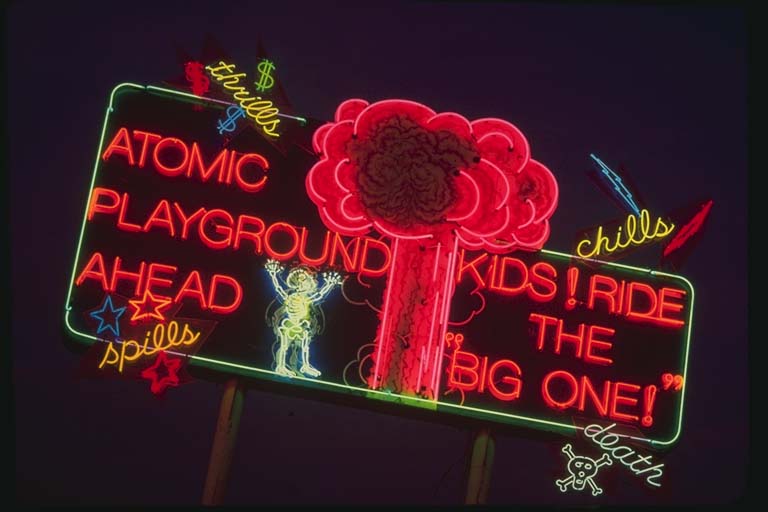

Theoretically, this, is one of the artists
simplest pieces, containing no sexual imagery, and should not have engendered
nearly the amount of controversy that it has. As part of its annual sculpture
invitational at Heritage Village in Columbus, Ohio Lawless was asked to
join 31 other artists in mostly large-scale installations that were requested
to be site specific. Lawless chose a site close to Interstate-70 where
he erected Didy Wah Didy named for the mythical railroad bound for
hell (Black Southern folklore.) With extremely simple imagery and few words
the piece is a timed neon sequence that shows a mushroom cloud forming
(animated) over a boys head. With the words "Atomic Playground Ahead" and
"Kids Ride the Big One!" it is a piercing send-up of typical American road
side attractions. In three of the four corners, constantly flashing are
the words "chills," "spills," "thrills." When the "kid", who starts out
smiling, then becomes alarmed, is finally "nuked," "death" with an alternating
skull and cross bones flashes in the lower right hand corner. Each of the
three flashing words are surrounded by the icons common in Lawless' work,
lightning bolts, dollar signs and stars. In all it is a timed sequence
of approximately sixty seconds.
The City of Columbus was not amused,
and cited Lawless for erecting a sign without a permit (and declared at
a well attended hearing that Lawless was not an artist but a "sign maker"),
in hopes of shutting it down. Practiced now in the ways of lawyers and
court, Lawless went to battle again for the right to exhibit his work.
Although the piece was damaged and temporairly turned off now, Lawless
won an early skirmish by obtaining a temporary restraining order prohibiting
anyone near the work (intimidation by the City resulted in the covering
of the piece in black plastic by the curators of the exhibtion.) At the
end of the exhbition as the sculpture was being taken down Common Pleas
Court of Columbus agreed with the City Commission that the sculpture was
not art but a sign.
It should not be taken lightly that Columbus, Ohio,
which is the home of the Ohio Arts Council, had just previously been embroiled
in a controvery over a Lichenstein sculpture at the airport. In both cases
there was not one word of support from the Ohio Arts Council for either
of the artists. An increasingly disturbing trend throughout the country
in the last ten years.
The sculpture is currently standing on Interstate
480, south of Cleveland, Ohio.
Article in New Art Examiner, January, 1989, page
68.
Cleveland Edition, September 22,
1988, 17.